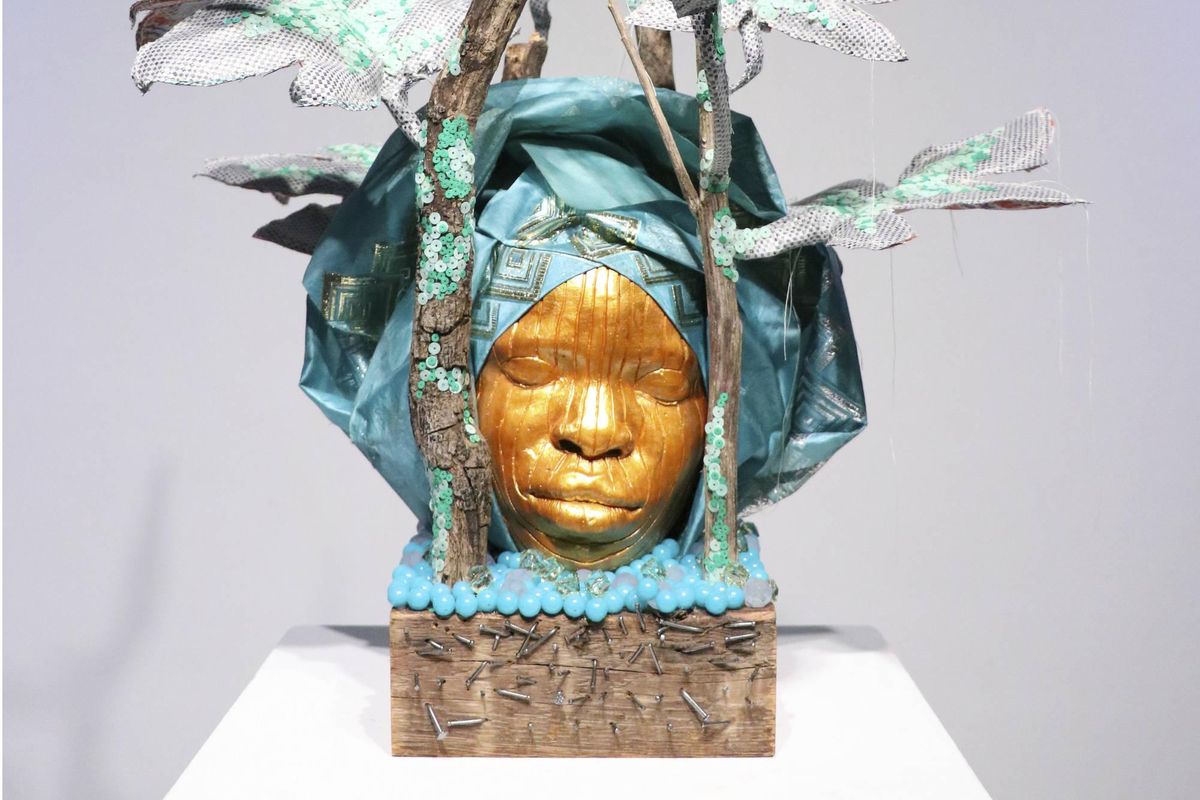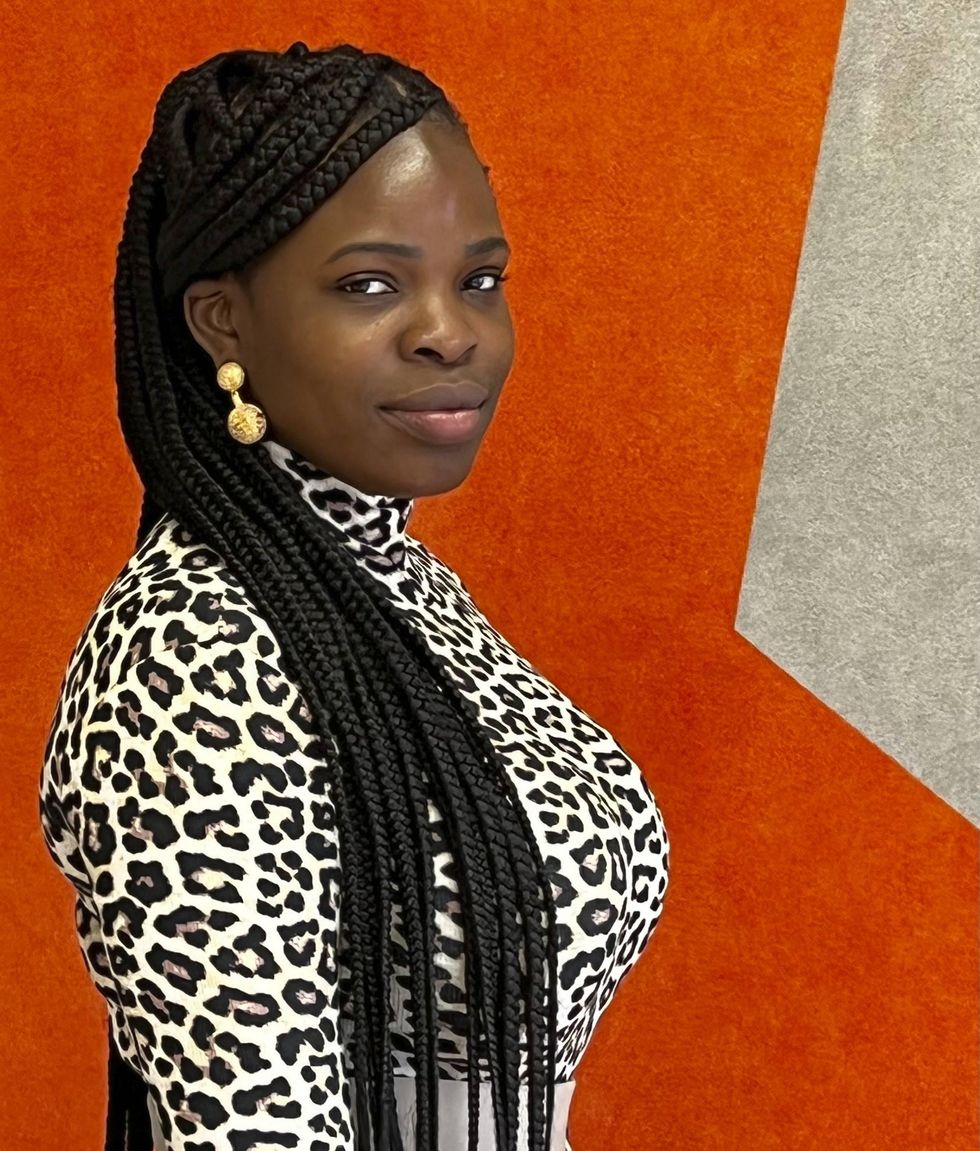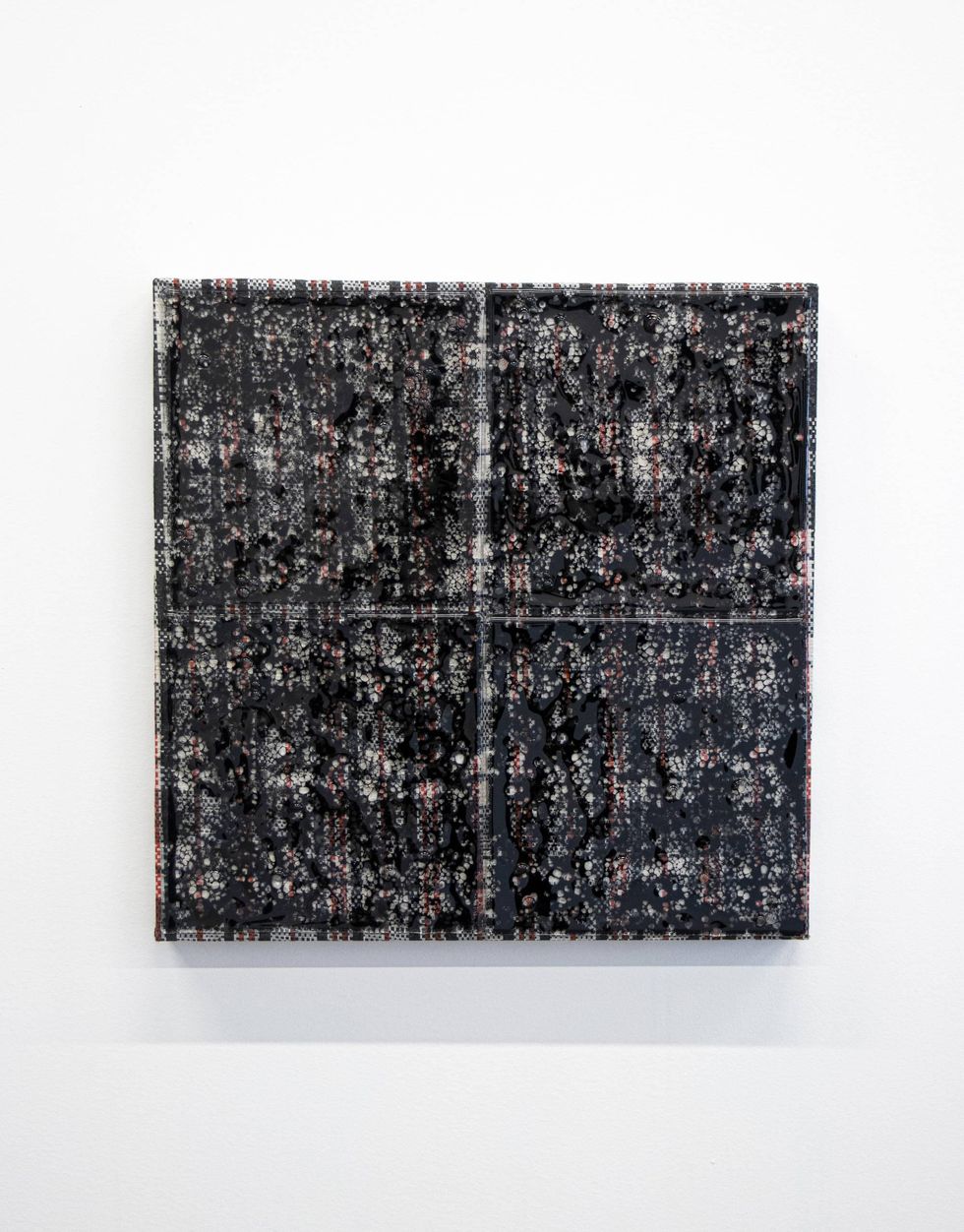How Nigerian Artist Layo Bright Uses Glass to Explore Migration
In the turbulent world of migration, Layo Bright’s sculptures creates spaces for African narratives

Layo Bright uses the Ghana-Must-Go bag in her work.
Perhaps the most striking motif in Layo Bright’s artwork is the sculpted female heads. In their close-eyed profile, they harken back to the precolonial artistic practice in West Africa, the bronze and terracotta heads in Nigeria with royal trappings. In the hands of Bright, they are recontextualized as a personal and broader commentary on cultural dynamics, identity, memory, colonization, displacement, and migration.
Some of her head pieces are intricately crowned with gele, a Yoruba head tie worn by the women in her homeland. At the base finds a foliage-like sprout made from checkered bags, or colloquially named Ghana-Must-Go. It’s a phrase that came along in '80s Nigeria to drive out undocumented immigrants, most of which where Ghanaians. These pieces are mounted on a wooden plaque, thus creating rich dimensions of texture.
Even more noteworthy is how Bright — who grew up in Lagos but is now based in New York — handles glass as a frontier of sculpting, the lack of opacity sometimes making them appear like slumbering oracles of sacred knowledge. Altogether, Bright has developed an artistic vocabulary informed by her experience, heritage, and a wider social climate on the continent. For this she’s garnered acclaim. Her sculptures have been featured in international exhibitions and installations such as Sotheby’s Institute of Art in New York, Smack Mellon, and Art Salon.
In 2021, Bright was enlisted as an Artist Fellow for NXTHVN, an American-based art initiative to support emerging artists. The Fellowship is ending with a group exhibition titled Undercurrents at Sean Kelly gallery, a capstone for which Bright showcases works like Double Standard and Vision. With the exhibition running from June 9 to August 5, 2022, Bright, tells OkayAfrica about finding her niche in the art world.

In 2021, Layo Bright was enlisted as an Artist Fellow for NXTHVN, an American-based art initiative to support emerging artists.
Photo Credit: Image by Marissa Del Toro.
What inspired you to become an artist?
I can’t pinpoint one event that inspired me to become an artist, but rather a series of events and people that encouraged me to develop a visual language. Fine Art was my favorite class when I attended secondary school in Nigeria. Mr. Bewaji, my art teacher, often talked about being an artist as a consistent practice: as a way of seeing, thinking, and expressing feelings.
Somehow Art class didn’t feel like just another class, and I’d find myself drawing and painting frequently in my spare time, even after class. Initially it was a way to unwind and channel my creativity, but I became more interested in the nuances of expression and how dynamic art could be. I guess it awakened a curiosity and restlessness in me, because I kept making works when I got into University for Law at Babcock University.
I would study my law texts during the day, and at night I would be sketching or painting. I carried on this way till I finished my Law degree and Law School. After Law School in Lagos, I became a studio assistant for Peju Alatise, a phenomenal Nigerian artist, and the experience encouraged me to devote myself to a consistent art practice of my own.

Layo Bright's Adebisi VII.
Courtesy of the artist and Monique Meloche Gallery
What were the conditions that informed your move to the US?
I moved to NYC in 2016 for an MFA at Parsons School of Design. Prior to that, I had just finished the Nigerian Bar exams after studying Law for four years. I had been painting and drawing during my spare time, but this was an opportunity for me to focus on my art practice and develop the skills and visual language I’d always desired. It was also a crucial point in me choosing to follow my passion for art, rather than a career in Law that many encouraged me to explore.
Glass is often a go-to medium in your work. Why glass?
It’s a dynamic and wonderful medium that I have been incorporating into my practice in recent years. Prior to that, I wasn’t even aware of glass as an art medium. It was a big part of my daily life, as with most people who use computers or smartphones or drink from a glass, but I hadn’t considered its potential as an art medium.
But a few years ago, I was awarded a scholarship to an UrbanGlass class in NYC where I was first introduced to glass making techniques. The class was for kiln casting, which is a process of casting sculptures in glass, but I soon got interested in other techniques and have continued to explore different ways of working with glass since then.

'In Plain Sight' fuses glass and Ghana-Must-Go bag on panel.
Courtesy of the artist and Monique Meloche Gallery
One of the themes you explore in your work is identity. As an artist with Nigerian heritage, what does identity mean?
For me, identity means how I define or see the self within my community and the world at large. It’s the factors that shape how I see myself, people around me, and how we are perceived. It goes back to the idea of kinship in terms of what characteristics are shared with others, and the places or communities that give one a sense of belonging. In that way I don’t think it’s strictly culture, or birthplace, but rather an amalgamation of how we are and who we are.
Is identity static?
I don’t think so. In my experience it hasn’t been, when I consider the complexities and nuances of communities, histories and cultures that I come from, which inform how my identity has taken shape. And I’m still expanding that, being shaped and formed by forces within and outside of my control. Since we don’t exist in a vacuum, our identity also isn’t fixed.
How is sculpting different from other artistic forms? Especially sculpting with glass.
I’m drawn to the tactile nature of sculpting and working with a range of materials that give a sense of touch. I work with different materials to make my sculptures, including wood, clay, pottery, glass, and textiles such as gele. The feel and technique to each one is different, and I enjoy that each requires something different from me. Whether it’s manipulating glass with heat, chiseling or burning wood, cutting and folding textiles, or shaping clay to resemble forms. I’ve always found it exciting to know how hands can mold materials to create representational forms.
Another theme that shows up in your work is migration, fusing the famous Ghana-Must-Go bags to explore displacement and forced movement. How did you arrive at this technique?
Curiosity and research led me to working with this technique. A couple of years ago, I came across the Ghana-Must-Go bag in a dollar store in Harlem, NYC. Up until that point and having spent most of my life in Nigeria, I was curious as to why I was finding the bag in a store so far from home. Asking questions and researching led me to the history of the bag initially invented in Japan, the history in Nigeria and how the bag got its name.
A xenophobic executive decree was passed by the Nigerian President in 1983 that led to the forced migration of over one million undocumented Ghanaians from Nigeria. The plastic checkered bags were lightweight, cheap, durable, and easily accessible to fleeing migrants to pack their belongings in. Following this incident, and the number of fleeing migrants that used the bags, it started to be known as Ghana-Must-Go bags in Nigeria.
In several parts of the world, the checkered tote bags are linked to migrant communities. I fuse sheets of glass that overlay the checkered plastic bag in my works, to disrupt the pattern and either reveal or conceal the pattern. Migration is the story of humankind in the sense that it has existed in every culture across the globe and is a key part of what makes us human.
Migration crisis is still happening in the world today. Just in the news recently, African refugees were killed to prevent them from crossing into the Moroccan/Spain border. How does that make you feel?
It’s difficult to convey in words how disheartening, frustrating and enraging it is to know of the injustices linked to African refugees migration. And to know that this is not the first time, nor likely the last, something like this would happen is bone chilling. Asides stories here and there, I didn’t have a full grasp on the inequities of African migration until I read Olusegun Adeniyi’sFrom Frying Pan to Fire, chronicling the journeys of several African migrants, the hostilities of many foreign countries, and how desensitized people and governments can be to the plight of black migrants. I wonder how many stories we’ve not heard, and how many didn’t make it to the news.
You are currently showing your work at the NXTHVN exhibition “Undercurrents,” a presentation from graduates of the Fellowship of which you are a part of. What has the reception been like?
It has been awesome! It’s great to have a culminating exhibition, but it has also been a celebration of the work that went into curating the exhibition by Curatorial Fellows: Jamillah Hinson and Marissa Del Toro; and making works over the past year by Studio Fellows: John Guzman, Alyssa Klauer, Africanus Okokon, Patrick Quarm, Daniel Ramos, and Warith Taha.
Jamillah and Marissa got to know our practices closely over the past year through studio visits and conversations, and it has been very fulfilling to see all the work come together. Having the exhibition at Sean Kelly has been a memorable experience to work with their incredible team alongside NXTHVN to plan towards the show.
We see the presence of kiln-casted foliage in works like “Visions.'' What themes were you trying to communicate here?
The Visions series are hybrid forms inspired by caryatids. On my daily walks in New Haven, Connecticut, I was inspired by the architectural moldings of the homes and buildings I came across. Sometimes they would have caryatids, which is a sculpted architectural pillar or supporting column of a female body. I became interested in combining female portraits inspired by family members with decorative molding and designs.
I’m interested in the position of women with regards to society, politics, and family with a specific lens on how they influence and support everyday structures, much like the caryatids who uphold physical buildings (literally and metaphorically) while bearing witness to the passing of time.
Are there challenges you face as an artist? Do you face barriers/issues working with glass?
Sculpting is resource heavy and expensive, but it’s too fun to stop.
- 5 Artists Leading Nigeria's NFT Scene - OkayAfrica ›
- 5 Nigerian Hyper-Realist Artists You Should Know - OkayAfrica ›
- Meet the Female Artists Making Waves in the Nigerian Art Scene ... ›
- Reverse Migration: Why North African Creatives are Returning Home - Okayplayer ›
- Why Deo Kato is Running Across Africa - Okayplayer ›
- How +234 Art Fair Is Trying To Demystify The Patronage of Nigerian Art | OkayAfrica ›

